17 Nov 2021 | Industry Insights
How Twinview can help tackle the climate crisis

COP26 has provided a stark reminder that climate change is well and truly a risk to humanity. Human influence has been a key driver behind the widespread and rapid changes in warming the atmosphere, ocean and land.
The scale of recent changes across the climate system as a whole is unprecedented over many centuries and thousands of years. Every region across the globe has been affected as evidence of observed changes in extreme weather such as heatwaves, heavy precipitation, droughts and cyclones have come to the fore.
A recent IPCC report found that global surface temperature will continue to rise until at least the mid-century. Global warming of 1.5°C and 2°C will be exceeded during the 21st century unless massive reductions in CO2 and other greenhouse gas emissions occur in the coming decades.
One of the biggest emitters of CO2 is the construction industry and we undoubtedly have one of the biggest roles to play in tackling the climate crisis. Buildings are responsible for 40% of CO2 emissions with 28% generated during operation. Governments worldwide have set ambitious targets to achieve Net Zero and the UK’s target is to achieve net-zero carbon by 2050 – in line with the Paris Agreement – with a 68% reduction target by the end of this decade.
In an effort to combat the effects of climate change within the property sector, many private businesses are looking towards product solutions to move them closer to Net Zero. Research carried out by GeSI suggests that the deployment of digital twins such as Twinview can contribute to a 20% reduction in global carbon dioxide emissions by 2030.
Why Twinview?
Over the past five years, Twinview has developed a digital twin platform specifically for the property sector to better assist building owners and operators to understand their estate. Buildings have always produced huge amounts of data, however, until the rise of digital twins within real estate there has been no way of accessing this information. Twinview unlocks access to your building’s data through the use of IoT and sensors with data streams available on a single easy-to-use dashboard, empowering building owners to make more informed decisions around energy consumption.
Twinview uses sophisticated artificial intelligence and machine learning to identify trends and patterns around energy use within a building. The more we understand where energy is being consumed, the better we can develop approaches to reduce carbon and move closer to Net Zero.
It is no longer enough to just replace a building’s bulbs with LED lighting or to ensure that heating functions operate via a timing system. By truly monitoring a building’s systems such as lighting, heating and cooling, Twinview ensures that it can achieve the optimal performance resulting in a reduced carbon footprint as well as reducing operational costs, improving efficiency and improving the occupier experience.
The power of customisable dashboards
Twinview's dashboards offer users the ability to federate and report on data across multiple projects at an organisation level as well as being able to create dashboards that are custom to the user’s specific needs.
Modern buildings are smart and are constantly monitoring and collecting data, however, all of the different systems are silos that are kept separate. Dashboards can bring all of this data together onto a single platform allowing the user to visualise and analyse the data, identifying patterns to improve a building’s operation.
Dashboards give the user the opportunity to have a complete breakdown of how their building is consuming energy such as heating, cooling and lighting, furthermore, Twinview utilises machine learning which can also predict how much energy the building will consume going forward based on current usage levels and by identifying patterns. This is vital for building owners as they can gain an insight into estimated energy costs for a certain period of time and make decisions to move their business closer to Net Zero.
Twinview is a browser-based digital twin platform for the property sector connecting building systems’ data to a 3D model viewed on a single dashboard. Twinview becomes your first step to achieving Net Zero by providing continuous live data and an optimised building performance whilst reducing costs and improving the user experience. Book a demo today.
Related insights

Industry Insights
The Intelligent Hotel: Navigating Costs with Digital Twins
The hotel industry, a sector once synonymous with bustling lobbies and seamless service, has weathered numerous challenges over the past decade. From pandemic-induced shutdowns to the relentless squeeze of rising costs and staffing headaches, hotel survival has become a masterclass in adaptation. Room demand reached an all-time high in 2024, according to STR research. As travellers return in mass, expectations have shifted, demanding a level of personalised experience that feels both effortless and intuitive. How do hotels meet the challenge? Enter the digital twin—a virtual representation reflecting the hotel's every heartbeat.
Read more

Case Studies
Preserving the Past, Powering the Future: Twinview's Role at Archives New Zealand
The newly constructed Archives New Zealand facility in the heart of Wellington represents a strategic investment in the long-term stewardship of the nation's invaluable historical records. Designed to provide a secure and stable environment for the preservation of national archival collections, safeguarding heritage isn’t just about secure storage; it requires a smart, resilient, and efficient environment supported by cutting-edge facilities management. To meet this challenge, Archives New Zealand partnered with Twinview and WT New Zealand to embed intelligence into the building's fabric. The result? A future-ready, high-performance facility where smart data meets operational excellence.
Read more

Industry Insights
Understanding Renters' Rights: How Digital Twins Improve Compliance and Property Management
The recent introduction of the Renters' Rights Bill in the UK aims to improve the relationship between tenants and landlords. As part of a broader effort to ensure fairer and more transparent living conditions, this bill ensures that rental properties meet specific standards, including affordability, maintenance, and habitability. Landlords and property managers now face new challenges in complying with evolving regulations. We explore how Digital Twins could support with these new compliance requirements.
Read more


